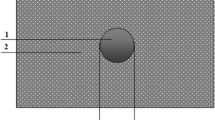Composites with an elastomeric matrix containing rigid particles of diameter 10–1000 µm are studied. One of possible mechanisms of the rheological behavior of such filled systems, related to the origination and growth of vacuoles near the rigid inclusions in a viscous matrix, is considered. For simulating the mechanism of formation of rheological properties of the filled elastomers, we use a structural cell in the form of an elastomeric cylinder, whose height and diameter are equal in magnitude, with a rigid spherical inclusion at its center. Deformation of the cells is examined with the observance of boundary conditions providing the preservation of their close packing. The inclusion is assumed to be rigid, and the matrix properties are described by equations of the linear hereditary viscoelasticity theory. The formation of vacuoles is described by using the approach suggesting that an initial debonding begins to propagate when the energy accumulated in the extended matrix reaches a value sufficient to create a new interface. The heterogeneity of the composite is simulated by taking into account the variability of the local filler concentration. Creep curves obtained for composite cells with different content of the solid phase are presented. Comparisons between the numerical and experimental results show a satisfactory agreement.
Similar content being viewed by others
References
F. R. Schwarzl, H. W. Bree, and C. J. Nederveen, “Mechanical properties of highly filled elastomers. I. Relationship between filler characteristics, shear moduli, and tensile properties,” in: Proc. 4th Int. Congr. Rheology. Vol. 3, Interscience/Wiley, New York (1965), pp. 241–263.
S. Ahmed and F. R. Jones, “A review of particulate reinforcement theories for polymer composites,” J. Mater. Sci., 25, 4933–4942 (1990).
Z. Gao and A. H. Tsou, “Mechanical properties of polymers containing fillers,” J. Polym. Sci., Pt. B: Polym. Phys., 37, 155–172 (1999).
R. Borst, “Numerical methods for debonding in composite materials,” in: Proc. IUTAM Symp., Poland (2005), pp. 13–21.
V. V. Moshev and O. K. Garishin, “Structural mechanics of dispersedly filled elastomeric composites,” Uspekhi Mekh., 3, No. 2, 3–36 (2005).
A. A. Adamov, V. P. Matveenko, N. A. Trufanov, and I. N. Shardakov, Methods of Applied Viscoelasticity, No. 411 [in Rus sian], Ural. Otd. Ross. Akad. Nauk, Ekaterinburg (2003), p. 410.
L. C. E. Struik, Y. W. Bree, and F. R. Schwarzl, “Mechanical properties of highly filled elastomers [III],” in: Proc. Int. Rub ber Conf., VcLaren and Sons, London (1967), pp. 205–233.
A. Meddad and B. Fisa, “A model for filler-matrix debonding in glass-bead-filled viscoelastic polymers,” J. Appl. Polym. Sci., 63, 2013–2024 (1997).
V. V. Moshev and L. L. Kozhevnikova, “Predictive potentialities of a cylindrical structural cell for particulate elastomeric composites,” Int. J. Solids Struct., 37, 1079–1097 (2000).
V. V. Moshev and L. L. Kozhevnikova, “Structural cell of particulate elastomeric composites under extension and compression,” Int. J. Solids Struct., 39, 449–465 (2002).
L. A. Golotina, L. L. Kozhevnikova, and T. B. Koshkina, “Modeling the mechanical behavior of particulate elastomeric composites by using spreadsheets,” Mech. Compos. Mater., 40, No. 6, 551–558 (2004).
R. A. Schapery, “A method of viscoelastic stress analysis using elastic solutions,” J. Franclin Inst., 6, No. 8, (1965).
L. L. Kozhevnikova, V. V. Moshev, and A. A. Rogovoy, “A continuum model for finite void growth around spherical inclusion,” Int. J. Solids Struct., 30, 237–248 (1993).
A. E. Oberth and R. S. Bruenner, “Tear phenomena around solid inclusions in castable elastomers,” Trans. Soc. Rheol., 9, 165–185 (1965).
K. Kendall, “The adhesion and surface energy of elastic solids,” J. Phys. D: Appl. Phys., 4, 1186–1195 (1971).
A. N. Gent, “Detachment of an elastic matrix from a rigid spherical inclusion,” J. Mater. Sci., 15, 2884–2888 (1980).
V. V. Moshev, A. L. Svistkov, et al., Structural Mechanisms of the Formation of Properties of Granular Composites [in Russian], Ural. Otd. Ross. Akad. Nauk, Ekaterinburg (1997).
Author information
Authors and Affiliations
Additional information
Translated from Mekhanika Kompozitnykh Materialov, Vol. 44, No. 6, pp. 895–906, November–December, 2008.
Rights and permissions
About this article
Cite this article
Golotina, L.A., Kozhevnikova, L.L. & Koshkina, T.B. Numerical simulation of the rheological properties of granular composites by using a structural approach. Mech Compos Mater 44, 633–640 (2008). https://doi.org/10.1007/s11029-009-9047-z
Received:
Revised:
Published:
Issue Date:
DOI: https://doi.org/10.1007/s11029-009-9047-z



